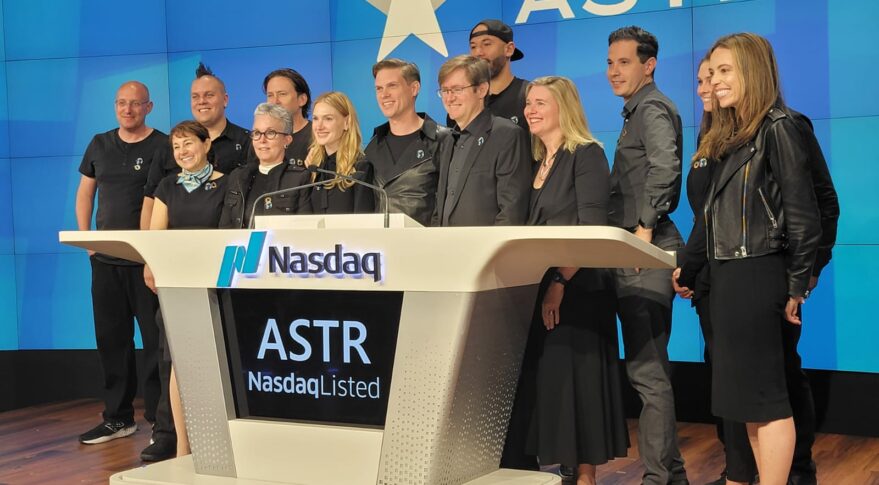Satellite Industry Trends to Watch in 2022
by Virgil Labrador, Editor-in-Chief
Los Angeles, Calif., January 15, 2022--We begin 2022 entering the 25th month of the global COVID-19 pandemic, with yet a new variant of the virus wreaking havoc on recovery plans worldwide. I can only describe the times we live in as Charles Dickens did in a "Tale of Two Cities" that "these are the best of times and these are the worst of times. " And yet there is a lot to be optimistic about 2022 and beyond. Just to provide some perspective, the number of satellites launched in 2020 and 2021 during the pandemic is almost equal to all the satellites launched in the previous three decades.
We look at the key developing trends in the satellite industry going forward.
The Impact of the COVID-19 Pandemic will Linger for Some Time
Despite the current omicron surge, which is showing signs of decline, the indicators are quite good that the pandemic is headed towards being endemic this year. This does not mean it will be going away, but will stay, albeit in a more manageable form, like the seasonal flu. The impact, however, of the global pandemic will be felt for a longer time, perhaps up to two more years.
The pandemic has disrupted supply chains and changed fundamentally how we live and do business and those effects will be here for some time. Some of the changes have actually been beneficial for the satellite and telecommunications industries. For example, the increased popularity of remote work and doing business virtually will drive bandwidth demands. Other effects can be detrimental to the economic recovery such as shortages of essential goods and materials due to supply chain disruptions. We will all have to live with these changes for a while and be prepared for the next pandemic. If we learned our lessons well from this pandemic and instituted measures that will prepare us for the inevitable coming pandemics, we should be in good stead.
Increased Investment in Space-related Ventures
2021 was a record year for investment capital flows in space-related ventures and companies. Consulting firm Space Capital estimates that in
 |
| Several startups have benefited from mergers with Special Acquisition Companies (SPACs) to raise funds for their ventures. Pictured here is upcoming launch services company ASTRA after its merger with Holicy, a SPAC controlled by cellular pioneer Craig McCaw, who co-founded Teledesic. (image courtesy of ASTRA) |
2021 aerospace companies raised some US$ 39 Billion. 2021 also saw mergers of satellite companies with Special Acquisition Companies (SPACs) which made it easier for startups to raise capital. Buoyed by high-profile space activities from Billionaires like Elon Musk, Jeff Bezos and Richard Branson, interest from the investment community in space ventures is at an all-time high. Despite some slowing down in SPAC activity towards the end of 2021, look to continued influx of investments in space in the next few years.
Innovations
The relative ease of raising capital has lowered the barriers to entry in the competitive satellite industry and led to a proliferation of start-up ventures. With increasing numbers of start-ups with access to funding comes many innovations. One example is Australian manufacturer Fleet Space Technologies which developed the first 3D-printed satellite. 3D printing enables custom-made satellites at much lower cost than conventional ones. Other innovations include optical or laser technologies and the use of artificial intelligence, among others.
Faced with increasing competition from niche manufacturers, the established satellite manufacturers have also stepped up their game with innovations such as software-defined satellites which are cheaper to build and more flexible. At the end of 2021, satellite operator Intelsat announced an order for two software-defined satellites from Thales Alenia Space designed to advance Intelsat’s global fabric of software-defined GEO connectivity as part of its 5G software-defined network.
Satellite manufacturer Boeing Commercial Satellite Systems has invested in 3D printing for small satellites through its subsidiary Millenium Space Systems.
Of course not all start-ups will be successful. Those who manage to rise above the pack might be ripe for takeover by the bigger players. Smaller companies might want to consolidate with other companies in order to be able to compete with the larger companies.
More Consolidation
2021 saw the mega-merger (by satellite standards) of Viasat and Inmarsat in a US$ 7.3 Billion transaction. The combination of the two companies created a powerhouse in key vertical markets such as mobile services, aeronautical and maritime, among others. Viasat previously acquired Rignet, a major service provider in the oil and gas business.
Even companies in bankruptcy proceedings like Speedcast was purchased by private investment firm Centerbridge Partners in March 2021. Speedcast emerged from bankruptcy debt-free (getting rid of US$ 634 million in debt from its balance sheet) and proceeded to consolidate its prior acquisitions and rebuild its business.
Look to have more consolidations as more companies enter the business and competition heats up.
Space Tourism Will Continue to Grow
Prior to Virgin Galactic's first suborbital flight carrying four commercial passengers including its Billionaire founder Richard Branson in July 11, 2021, only about 580 people have been to space. Since that historic flight in July more than 20 more civilians or "space tourists" have gone to space. NSR’s newly released Space Tourism & Travel Markets, 3rd Edition (STT3) report sees over 57,500 passengers heading to space through the decade, generating US$ 20.3 Billion cumulative revenues. NSR’s STT3 finds the rapid growth seen in the Space Tourism & Travel Markets driven by a growing commercial passenger interest, along with government funding and demand.
As the most stable and lucrative segment through 2031, Orbital Travel is set to capture 66% of total revenue opportunity. Orbital Travel has strong government support with initiatives such as the Commercial Crew program and commercial company led Space Station development. High ticket prices, coupled with very strong demand, results in a fast-growing market, even among delays according to NSR.
Space and National Security
Despite a year of uncertainty, the space sector has received record government investment totaling over $92 Billion, an 8% increase compared to 2020 according to Euroconsult. Civilian space budgets, totaling US$ 53 billion in 2021, continue to receive more funding than defense space programs, at 58% of total spending, though the share going to defense, US$ 39 billion in 2021, is increasing. Geopolitical tensions, increasing rivalry between leading space powers, and the value of space as the ultimate high ground drive the militarization of space trend, with leaders increasing their investments in defense space assets and technologies.
The Space Symposium held in late August 2021 in Colorado Springs highlighted the ambitious plans of the US Space Force--the first dedicated national space security organization. We are now seeing other countries planning to follow suit and create their own national space forces.
Tensions are also running high when last November 14, Russia used an anti-satellite weapon (ASAT) to destroy a retired satellite, Cosmos 1408. This could lead to a new "arms race" in space.
Broadband and Mobility to Drive Demand for Telecom Services
In November 2021, the International Telecommunications Union released a report that revealed that an estimated 37 per cent of the world's population–or 2.9 billion people–still have never accessed the Internet, 97% of which are in developing countries.
The global pandemic accentuated the need to be connected for most of the world's population. It is clear that broadband access and mobility will be driving demand for satellite and telecom services in the next few years. Spacex' Starlink Low Earth Orbit (LEO) constellation has already launched 2,000 satellites in the past two years and are planning thousands more to address the insatiable demand for broadband connectivity.
Satellite companies would want to reach out to as many of the addressable market for broadband services. ABI Research estimates that the serviceable addressable market (SAM) for global satellite broadband over geostationary (GEO), medium earth orbit (MEO) and low earth orbit (LEO) satellites will be 330 million premises, equivalent to 1.3 billion household members, in 2026. They will be facing stiff competition from telecom companies that provide fiber and other ground-based solutions. But, the satellite industry, which has proven its resilience through many challenging situations in the past have been slowly transforming itself to be more like telecom companies by providing hybrid services and other creative connectivity solutions.
The last two years in some ways has certainly been one of the worst of times, but the next few years could be one of the best of times.
--------------
 Virgil Labrador is the Editor-in-Chief of Los Angeles, California-based Satellite Markets and Research which publishes a web portal on the satellite industry www.satellitemarkets.com, the monthly Satellite Executive Briefing magazine and occasional industry reports called MarketBriefs. Virgil is one of the few trade journalists who has a proven track record working in the commercial satellite industry. He worked as a senior executive for a teleport in Singapore, the Asia Broadcast Center, then-owned by the US broadcasting company CBS. He has co-authored two books on the history of satellite communications and satellite technology. He holds a Master’s in Communications Management from the University of Southern California (USC). He can be reached at virgil@satellitemarkets.com
Virgil Labrador is the Editor-in-Chief of Los Angeles, California-based Satellite Markets and Research which publishes a web portal on the satellite industry www.satellitemarkets.com, the monthly Satellite Executive Briefing magazine and occasional industry reports called MarketBriefs. Virgil is one of the few trade journalists who has a proven track record working in the commercial satellite industry. He worked as a senior executive for a teleport in Singapore, the Asia Broadcast Center, then-owned by the US broadcasting company CBS. He has co-authored two books on the history of satellite communications and satellite technology. He holds a Master’s in Communications Management from the University of Southern California (USC). He can be reached at virgil@satellitemarkets.com






